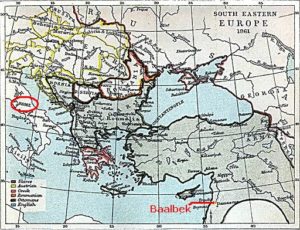Why did the Romans build their largest temple so far from home?

Historical map, 1861, Europe from Rome to Near East, marked to show Rome and Baalbek, Lebanon; Attribution: By J.B. Bury [Public domain], via Wikimedia Commons
In attempting to answer this question, an article entitled “Are the World’s Biggest Building Blocks Prehistoric?” examined the shortcomings of Roman technology and points out shortcomings of their ability to transport large monoliths.
The article seems to point to the availability of good-quality limestone, the prestigious or advantageous situation of Baalbek, and the relative ease of embellishing (over 200 years) an already somewhat developed temple site, as reasons why the Romans constructed this biggest Roman temple complex in the world.
In 27 BC, the Roman emperor Augustus supposedly took the unfathomable decision to build in the middle of nowhere the grandest and mightiest temple of antiquity, the Temple of Jupiter, whose platform, and big courtyard are retained by three walls containing twenty-seven limestone blocks, unequaled in size anywhere in the world, as they all weigh in excess of 300 metric tons. Three of the blocks, however, weigh more than 800 tons each. This block trio is world-renowned as the “Trilithon”.
If we think within the official academic framework of history, Augustus had no obvious reasons for selecting Baalbek as the temple’s building site. Supposedly, Baalbek was just a small city on a trading route to Damascus through the Bekaa valley in Lebanese mountains, about sixty kilometers from the Mediterranean coast (34º lat., 36º long.) At that time, it was of no special religious significance, apart from being in the centre of a burial region, in the midst of of thousands of rock cut tombs.
But, lavishing great architecture on Baalbek then seems totally out of character for the undeniably selfish Rome, which had at the very same time been stealing historic treasures from other countries, such as the obelisks from Egypt.
It makes more sense that Baalbek had something no other place could offer, not even the city of Rome, the heart of the empire. This something may also be the reason why so many people wished to be buried there.
Indeed, it has been noted that the blocks in the retaining wall (enclosure) of the Baalbek temple site clearly look a lot more eroded than the bona fide Roman ruins of the Temple of Jupiter, as well as those of the other two Roman temples also on the site. Therefore, the heavily eroded blocks should be much older.
This fact naturally gives rise to a different scenario: At Baalbek Rome had found a fabulous ready made foundation, a mighty platform to add a suitably majestic structure to, stamping the Roman eagle upon the whole for the perception of future generations.
Source: Article by Jiri Mruzek.
The International Dictionary of Historic Places has described that the location was central between coastal cities and Damascus, Syria; and identifies that springs in the vicinity made it a stop for trade caravans.
The Dictionary (id.) summarizes that the Romans recognized Baalbek’s strategic importance for controlling both the coastal cities and inland territories.
Wikipedia’s article on the Beqaa Valley also notes that the Romans took advantage of the agricultural capabilities of the region and used it as a source of grain for their provinces.
Source: Wikipedia, “Beqaa Valley”.
Next Page: Why did the Baalbek temple complex fall into ruin?



